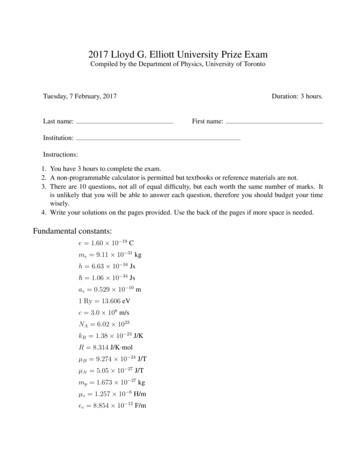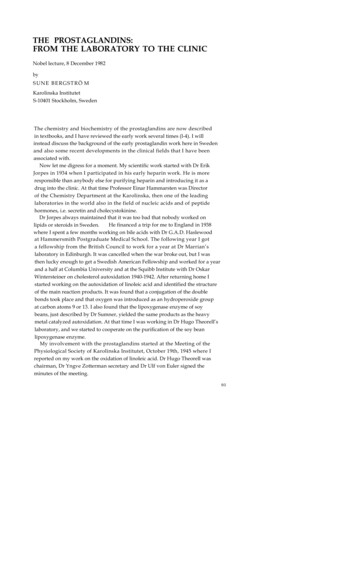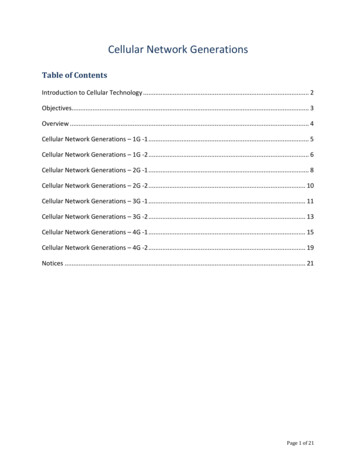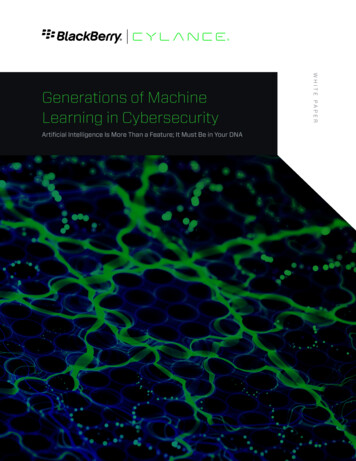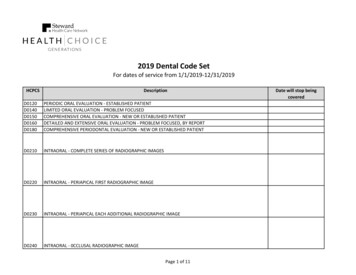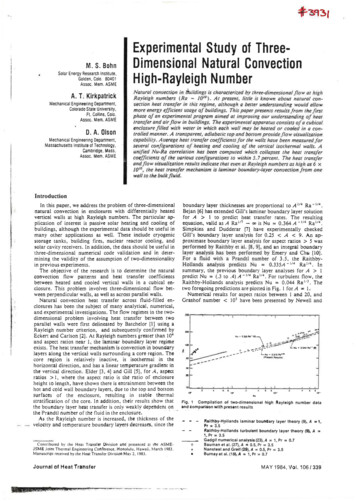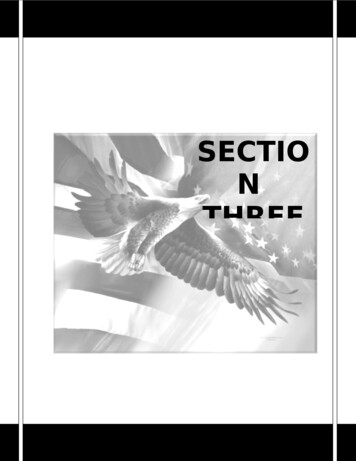
Transcription
Three GenerationsPrize for First-Year WritingSpring 2020with essays bySophia Angus ‘23 and Emily Lu ‘23Writing Program
ContentsPrefaceComments from the Judges33Sophia Angus (tied for first place)Imagining Storm in the MountainsSubmitted by Barbara Lynn-Davis (Art)5Emily Lu (tied for first place)Reflections on Grief, Remembrance, and Racein Yusef Komunyakaa’s “Facing It”Submitted by Jeannine Johnson (Writing Program)142
Three Generations Prizes for First-Year WritingThe Three Generations Prizes are supported by three generations of Wellesleyalumnae: Judith Stern Randal; her daughter, Judith Randal Hines; and her mother, SybilCohen Stern. By providing a means of publicly recognizing excellence in writing acrossthe disciplines, they demonstrate the enduring value that Wellesley College and itsstudents place on the ability to write clearly and effectively. Their gift has contributedmuch to foster rich, engaging writing at Wellesley.Each semester, a prize is awarded to a first-year Wellesley student foroutstanding written course work. Students are nominated by their First-Year Writingcourse instructors based on work completed for those courses. These prizes recognizeWellesley College's commitment to fine writing in all areas of study. Each prize is judgedby three faculty members who taught First-Year Writing during that semester.The winning papers show the development of a full and complex argument that isclearly stated and well-supported by evidence, argumentation and analysis that isaccurate and appropriate to the discipline, a level of diction that is sophisticated yetcomprehensible to an intelligent reader, and excellent presentation of source material,data, and other evidence.Comments from the Judges on the Winning PapersJudges: Jeannine Johnson (Writing), Lizzie Krontiris (Writing), Marilyn Sides (English)Two essays tied for first prize: Sophia Angus’ essay, “Imagining Storm in theMountains,” written for Barbara Lynn-Davis’s course, WRIT 107: Introduction to theHistories of Art, and Emily Lu’s essay, “Reflections on Grief, Remembrance, and Racein Yusef Komunyakaa’s “Facing It,” written for Jeannine Johnson’s course, WRIT 144:What’s in A Name? Investigating What We Call People, Places, and Things.The judges agreed to award two prizes in this round of awards due to the highquality of both pieces, and also because they reflect the variability and scope of firstyear writing at Wellesley. The two essays tied for first place together represent differentways of combining the personal and reflective with the public and analytical. The judgesfound them, individually and as a pair, to demonstrate well the possibilities of the essayform in the acutely challenging days of 2020.We picked Sophia Angus’ essay, “Imagining Storm in the Mountains,” for itssharp, funny, and subtle take on a great assignment that’s a little off the beaten path ofthe typical academic essay. Sophia, from her quarantine desk at home, imagines drivinginto an Alfred Bierstadt landscape. Her writing excels on all counts of what good writingentails: it possesses terrific detail, elegant structure, and a real voice that bringseverything together. It also contains sentences that feel truly shaped, such as, “I’mcemented to my desk chair, my eyes are straining to focus on my computer screen,staring at a painting that somehow captures my not-really-regretful feelings of regret formoments past when I didn’t stop the car to look, to pause, to feel, to smell.” The readergets a wonderful feel for the Bierstadt painting, but also for Sophia’s own lively,thoughtful, and moving quarantine-scape.3
Emily Lu’s essay, “Reflections on Grief, Remembrance, and Race in YusefKomunyakaa’s ‘Facing It,’” interrogates Komunyakaa’s poem about visiting the VietnamVeterans Memorial by focusing on his engagement with the memorial’s reflectivesurface. Lu’s incisiveness allows for a rich and insightful reading of the poem’s tensionsand contradictions – how Komunyakaa’s contemplation of his “distorted reflection”expresses a complex ambivalence about being a Black veteran of the war. Theargument is beautifully articulated, and Lu does a graceful job interweaving an analysisof Komunyakaa’s reception of the memorial with Maya Lin’s own statements about herintentions in its design. The reader comes away moved and unsettled by the question ofwhat it means for Komunyakaa to mourn the war.4
WRIT 107 Spring 2020Fourth paper assignment:The significance of landscapeGuo Xi’s The Significance of Landscape, an 11th-century meditation on the role oflandscape art in a person’s life, is a remarkable text. There’s nothing like it written in theWest for hundreds of years.We have a sense of the artist’s deep familiarity with the natural world around him: thevoices of apes and call of birds the glow of the mountain and the color of the waters clouds and vapors that differ through the four seasons wind and rain.But what’s most amazing about this text is its articulation of how imagination of theseplaces, through landscape painting, is a balm for the weary soul: Without leaving yourroom you may sit to your heart’s content among streams and valleys.He was addressing civic officials who worked in the emperor’s government, doing theirduty day in/day out for the sake of family and social honor.It occurred to me, each of us right now is a weary trapped soul in need of a balm!We will use a selection of American 19th-century landscape paintings related to theHudson River School as jumping off points to imagine ourselves outside in wide nature,and beyond our current predicament.Please choose one painting to escape into:Thomas Cole, Sunset in the Catskills, 1841 (MFA)Thomas Cole, An Italian Autumn, 1844 (MFA)John Frederick Kensett, Mt. Washington from the Valley of Conway, 1865 (Davis)William Louis Sonntag, Autumn in the White Mountains, 1865 (Davis)Albert Bierstadt, Storm in the Mountains, about 1870 (MFA)I have provided photographs of each of these paintings on our Sakai site: Resources Research and Writing Tools Resources for paper #4I have also included two short, general readings about the Hudson River School if you’dlike to get more grounded in the style.5
Approach:Your paper will be 3-4 pages. Because the assignment is unconventional and we’re allin a muddle right now, I’m outlining specifically below what to include. However, this isnot intended as a strict box. Add, subtract, as the painting speaks to you.Introduction.Tell your reader in first-person where you are based, what your daily life is like. Can yougo outside? If so, where do you go? What draws you to this place, what is it giving youright now? Conjure it for your reader with rich and generous descriptive language, so wecan go there in our minds with you. If you’re confined to a room or house, tell us aboutthat space. What is it like?Body of paper.Part 1 (probably, a paragraph): Identify your painting and tell your reader what drew youto it: its aesthetic or visual qualities? A memory? A desire or fantasy?Part 2 (probably, several paragraphs): Wander through it with Guo Xi’s sense for detail.What do you encounter first, second, next? What do the textures feel like on yourfingers? Is there wind on your face? What’s the sun doing, how does it feel on yourbody? Might you go for a swim? Take out a sketchbook or your journal? Take pictures,or be glad to dump your phone after quarantine?! This is a visual analysis with a “3D I’min the painting” twist. I suggest you review Terms for Formal Analysis on Sakai Research and Writing Tools, to get your wheels turning.Part 3: Finally, tell your reader about a place you most dream of going when this is allover. Why? Have you been before, or it’s a new destination? Once again, conjure it foryour reader with rich and generous descriptive language, so we can go there with you.What do you imagine yourself seeing around you, and doing there? Small momentdescription will probably work best (Like, “I’m at a cafe in Paris ”)No formal conclusion is needed your conclusion is in essence, a dream or vision your own “heart’s content” at Guo Xi puts it.Important Dates:6
4/21: Assignment given. Be sure to watch the 30-minute video lecture by James Cahill.The first 12 minutes discusses the reading relevant to the paper topic; the next partlooks closely at Guo Xi’s Early Spring and will help introduce you to the idea ofwandering through a painted landscape.4/28: 10-minute phone meetings with me to discuss the paper. You must have chosenyour painting and I’d like to hear about the other parts you envision.5/1: First draft due to me by email. I will provide early feedback.5/5: Virtual editing groups with your pod.*5/10: Final draft due.*Note: All work for the course must also be completed by this date.7
Sophia AngusProfessor Barbara Lynn-DavisWRIT 10731 May 2020Imagining Storm in the Mountains7 am, I gently wake up (by my alarm obviously. Definitely not by my mother).Delicate light streams into my small room, illuminating the contents of my four-walledbox; a crisp and soothing wind creeps into my room from my cracked window to hug myarms as I stretch, lulling me back to sleep. My parents call for me again. They’re readyto go on our morning family walk. With my teeth brushed, shades on, and hat snug onmy head, we head out. It’s my favorite time of day because it’s before the day hasstarted-- even the sun has yet to heat the world around me. My family and I walk alongthe side of the road, up the hill, talking about nothing in particular. I keep my eye out forsnail tracks glistening on the dark asphalt; making up stories about the snails makes mydad laugh. At the crest of the hill, I look past the fields of alfalfa, or some other grassything, to the hills of California, fresh green turning into liquid gold. They cradle me. I lookto my right to the open space and greenery of the golf course we live on. My life couldbe a lot worse. We pass the sweet-smelling bush, the one that my brother says remindshim of jasmine boba tea. The tree leaves are glowing from the yellow sunshine, and itreminds me of that summer feeling when Still Woozy plays in the background.I return home, just enough time to pee before my only synchronous class of theday at 8:20, then after, I que this month’s playlist of artists and songs I discovered in thelast few weeks. I now enter a cycle of 50-10 Pomodoro sessions. 50 minutes of densework followed by a ten-minute intermission; rinse and repeat. After a few sessions, I’ll8
stretch my legs and chill with my dogs outside, staring at my neighbor’s tree that isalways buzzing with bees, hoping to get my eyes to focus on something farther awaythan my screen. Today, I sit at my desk staring at Albert Bierstadt’s Storm in theMountains (1870) [Figure 1], getting ready to write my fourth paper.I guess I chose this piece because it reminds me of home, Hollister, California-not to be confused with Hollister Co. by Abercrombie & Fitch Co. Hollister is a ruralcommunity with a rebellious flavor: we are very popular in the biker community thanks tothe 1953 film The Wild One, which shot a few scenes in our downtown. Just like inStorm in the Mountains, bushy trees tickle the fields that surround my hometown,appearing kelly green in the warm light, an idyllic haven protected by mountains.Different plots of farmland slice the valley into small sections. When I look out into thedistance in any direction, I see that same atmospheric perspective Bierstadt paints sobeautifully, only instead of restrictive mountains with frozen caps, I see the expansivetroughs and crests of the hills that roll around me. And in the wintertime, I look forwardto watching the encroaching storm clouds. Nothing obstructs my view. After a good rain,the smell of sweet California dirt wafts through our city.Looking at Bierstadt’s painting, I am reminded of the many times I would glanceout the window of my car, driving back from whatever I was doing, and I’d be drawnback to the reality that exists outside of my head to witness the passing scene. I wouldconsider maybe trying to take a picture. But I knew that it could never capture what I’mtrying to capture: nostalgia of years of driving in this distant oasis, tranquility and warmthfrom the sunlight of many lazy days outside, awe because there is nothing quite like thisanywhere else in the world. Feeling insignificant-- not in a bad way, but in the way that9
reminds me that the problems that occupy my mind aren’t as big as they feel, so whyworry. Also, I’m driving, so I really shouldn’t be using my phone.As I look at this painting on my screen, I can feel myself wishing I could drivetoward the warmth at the center of its light, lay on the grass, do nothing. Let's pretend Iwas driving, and I did what I've always wanted to do: drive off the main road and rideinto the heart of the light. Peering through my window shield, gaping at the incrediblescene before me, I’d chase the deep olive mountains ascending toward an innocentblue. I would drive onward, eventually passing the classic crimson barn that seemed sosmall before, unable to see the livestock, but definitely smelling them even with thewindows rolled up. The once-little trees would tower over me, lining the paved road thatcarries me farther and farther away from the main street, from my normal life.Eventually, the lane would become a dirt path, wonky, so I would slow. I might roll mywindows down, listening to the crunch of rubble rolling under my tires. Now, the warmair brushes the hair out of my face, and I imagine it’d smell the way things smell afterbeing left out in the sun for too long. The buzzing of evening insects might fill the air, thelooming mountain on my left would track my journey across the little valley to itsneighbor. Maybe “Foreign Fields” by Kacy Hill percolates into the world I drive past, thegentle last chorus coming to a close before I park to explore.After a beautiful eternity of driving, I plop onto the
I guess I chose this piece because it reminds me of home, Hollister, California- not to be confused with Hollister Co. by Abercrombie & Fitch Co. Hollister is a

